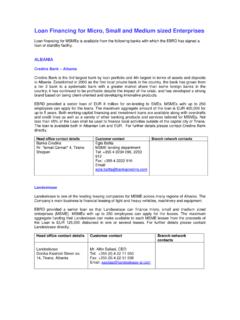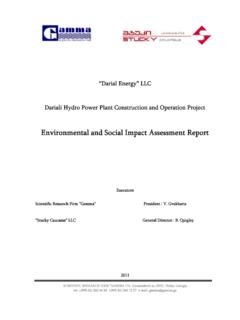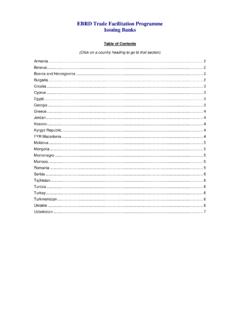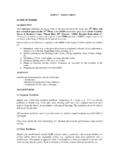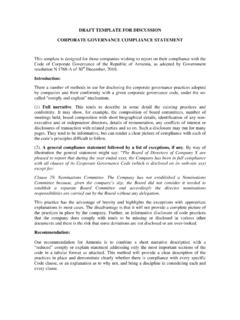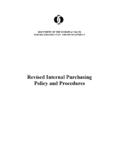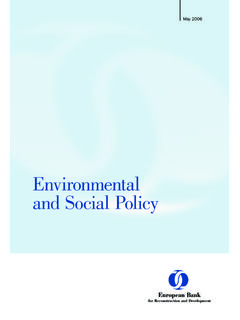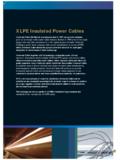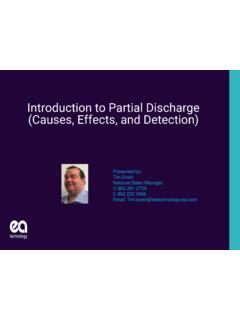Transcription of STAKEHOLDER ENGAGEMENT PLAN (Sample Contents)
1 STAKEHOLDER ENGAGEMENT plan and Grievance Mechanism for IBUK 1 WINDFARM Vetroelektrane Balkana (Wind Energy Balkan Group) / Continental Wind Partners May 2012 (updated in February 2013) ibuk 1 Windfarm STAKEHOLDER ENGAGEMENT plan and Grievance Mechanism 2 Table of Contents 1 Introduction .. 3 2 Project Description .. 3 Project Location .. 3 Project Characteristics .. 3 Need for the Development .. 5 Summary of Expected Impacts .. 5 3 Regulatory Requirements .. 6 National Requirements .. 6 EBRD Requirements .. 7 4 Summary of Previous STAKEHOLDER ENGAGEMENT Activities .. 7 5 STAKEHOLDER Identification and Analysis .. 9 6 Disclosure of Information and STAKEHOLDER ENGAGEMENT .. 11 7 Grievance Mechanism .. 11 8 Contact Details for the Public .. 12 ibuk 1 Windfarm STAKEHOLDER ENGAGEMENT plan and Grievance Mechanism 3 1 INTRODUCTION The Wind Energy Balkan Group, Belgrade (Vetroelektrane Balkana , Beograd) and Continental Wind Partners, (together referenced in this document as WEBG ) are proposing to develop the ibuk 1 wind farm at a site approximately 30 km to the north east of Belgrade in Serbia.
2 Effective STAKEHOLDER ENGAGEMENT is needed to avoid and minimise the social risks of the proposed ibuk 1 Windfarm Project ( the Project ) and to ensure that the Project has a long term social licence to operate. This document is a STAKEHOLDER ENGAGEMENT plan (SEP) describing the planned STAKEHOLDER consultation and ENGAGEMENT process for the Project. It outlines a systematic approach to STAKEHOLDER ENGAGEMENT that will help WEBG develop and maintain over time a constructive relationship with their stakeholders throughout the duration of the Project. The document also includes a grievance mechanism for stakeholders to raise their concerns about the Project. The SEP has been produced in accordance with the international standards required by the European Bank for Reconstruction and Development (EBRD), and other international financial institutions (IFIs), as the Project might require financing from EBRD and potentially from other international investment banks.
3 The SEP is a living document and it will be regularly monitored, reviewed and updated by WEBG throughout all stages of Project implementation. 2 PROJECT DESCRIPTION PROJECT LOCATION The site of the proposed wind farm is located about 30 km to the north east of Belgrade in the municipality of Kovin, Autonomous Province of Vojvodina. The site covers an area of about 37 km2. The location of the wind farm site is shown in Figure 1, and the proposed layout is shown in Figure 2, below. The site is set on a slightly elevated position within generally flat to gently undulating surroundings. The land is in agricultural use and is intensively farmed. The local area is sparsely populated but the nearest village, Dolovo, is less than 2 km to the south west of the wind farm boundary, and there are weekend houses and some residences on the north eastern boundary at approximately 800 m in Devoja ki bunar.
4 Road access is adequate and provides good connection to the River Danube port at Pan evo. To the east, the proposed wind farm borders the Deliblato Sands International Bird Area (IBA), a Special Nature Reserve (SNR) and part of Serbia s Tentative List for inclusion in UNESCO s list of World Heritage Sites. PROJECT CHARACTERISTICS The ibuk 1 wind farm will include the construction of 57 wind turbines, access roads and energy infrastructure. Each turbine will be able to produce MW of electrical power ; the wind farm will have a maximum generating capacity of MW. The final decision on the wind turbine has been made (GE ), and the total maximum height of each wind turbine will be 170m including the tower and the blade radius. Each turbine will have 3 blades with a maximum rotor diameter of 120m. It should be noted that the final turbine and blade dimensions may be less than this. ibuk 1 Windfarm STAKEHOLDER ENGAGEMENT plan and Grievance Mechanism 4 Figure 1 Site Location Figure 2 Wind Farm Layout ibuk 1 Windfarm STAKEHOLDER ENGAGEMENT plan and Grievance Mechanism 5 The wind farm also includes the following infrastructure: areas of hard standing: each turbine would require a work area to accommodate the crane and turbine components during construction; underground , medium voltage electric power cables connecting the turbines with a transformer station transformer station ( medium / high voltage ), located well within the boundary of the wind farm km-long high- voltage power line (400kV) connecting the transformer station and the overhead power line (400kV) at Bavani te.
5 Service and access roads (the length and final position of the roads to be constructed / upgraded is not yet known). There is no requirement for a construction camp to house the construction workforce the workforce will be accommodated locally. Construction of the wind farm will start during Quarter 3 (Q3) of 2013 and be completed by Q4 2014. Development of roads and foundations will be undertaken between Q3 2013 and Q3 2014. Installation of the wind turbine generators (WTG) is expected to start Q2 2014. Since construction is phased, the site will be able to deliver electricity to the grid before construction of all turbines is completed. It is expected that the site will go live by Q3 2014, with construction of the overhead power line starting in Q1 2014 and being completed by Q3 2014. The operational life time of the wind farm is expected to be approximately 25 years which is typical of the wind turbine blade life time.
6 NEED FOR THE DEVELOPMENT The proposed wind farm is needed because: it will provide a valuable source of renewable energy for use within the country to support infrastructure development and the national building programme; it will reduce the need for Serbia to import energy from neighbouring countries; it will reduce the country s reliability on fossil fuel combustion; it will mark Serbia as a developing state with a commitment to reduce its Greenhouse Gas (GHG) emissions; it will provide local jobs and improvements, specifically during the construction programme; it may act as a tourist attraction to the area. SUMMARY OF EXPECTED IMPACTS An environmental and social impact assessment has been carried out for the three phases of the Project: construction, operation and decommissioning. Impacts have been classified as those related to ecology and nature conservation, landscape and visual impacts, traffic and transport, noise, socio-economic impacts, health safety and public nuisance, emissions to ground and water, air emissions, archeology and cultural heritage, electric and magnetic fields and electromagnetic interference.
7 Identified impacts can be managed and mitigated in accordance with best practice. The measures that will be adopted include informing the local population in a timely manner about construction activities and repairing any damages made to local access roads, as well as restoring any disturbed land. The implementation of the Project is requiring some land acquisition which has been and will continue to be implemented through voluntary transactions without the use of compulsory procedures. ibuk 1 Windfarm STAKEHOLDER ENGAGEMENT plan and Grievance Mechanism 6 A more detailed presentation of all project impacts and foreseen mitigation measures is presented in the Project Environmental and Social Impact Statement (ESIS) and the Environmental and Social Action plan (ESAP), available in the following locations: electronic copy WEBG office in Belgrade hard copies Local community offices in Mramorak, Dolovo, Vladimirovac and Bavani te hard copies.
8 3 REGULATORY REQUIREMENTS NATIONAL REQUIREMENTS Requirements in relation to public disclosure, participation and access to information kept by state bodies and organisations, as well as the right to petition state authorities and the right to a healthy environment in Serbia are prescribed by the Constitution of the Republic of Serbia (Official Gazette of the RS No. 98-2006). Serbia ratified the Aarhus Convention in 2009, by adopting the Law on Confirming the Convention on Access to Information, Public Participation in Decision-making and Access to Justice in Environmental Matters (Official Gazette of the RS No. 38/09). The basic principles contained in this Convention are supported by other Serbian laws and bylaws, including: The Environmental Protection Law (Official Gazette of the RS 135/2004 and 36/2009) The Law on Environmental Impact Assessment of the Republic of Serbia (Official Gazette of the RS 135/04 and 36/09) The Law on Strategic Environmental Impact Assessments (Official Gazette of the RS 135/2004 and 88/2010) These regulations require the public to be informed about and involved in all matters concerning the environment.
9 Depending on a number of factors, including the size / scale of the project, municipal or republic level authorities in charge of environmental protection determine whether an EIA for a particular project is required. If it is required, as is the case with this Project, the same authorities are in charge of organising disclosure and public consultations in line with the Rules for Disclosure of Information, Presentations and Public Consultations Regarding EIAs (Official Gazette of the RS 69/2005). Serbia also has a Law on Free Access to Information of Public Importance (Official Gazette of the RS, No. 120/04, 54/07, 104/09, 36/2010), which stipulates that everyone has the right to access information of public importance. Information of public importance is information held by a public authority body, created during work or related to the work of the public authority body, contained in a document, and related to everything that the public has a justified interest to know.
10 The Law on Planning and Construction of the Republic of Serbia (Official Gazette of the RS 72/09, 81/09, 64/10, 24/11) regulates the development and adoption of spatial and urban planning documents in Serbia, which are all subject to a public disclosure and consultation process. These plans are categorised as spatial plans, master plans, regulation plans, etc. Planning documents are displayed for public scrutiny after the technical review is completed and this has to be announced in a daily and local newspaper. The process is managed by the Agency for Spatial Planning of the Republic of Serbia the body of the local self-government unit responsible for spatial and urban planning. Once the process is complete, the competent authority is obliged to prepare a report containing all remarks, which is submitted to the document developer who is obliged to act upon these remarks.
